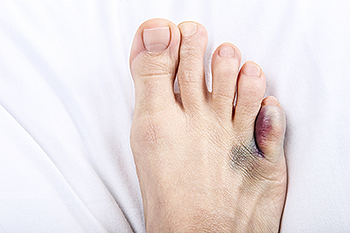Connect With Us
Blog

Fractures to the 5th metatarsal, or the pinky toe, are quite common. When the fracture occurs in the middle section of the metatarsal, it is known as a Jones fracture. The main cause is sudden force on the outside of the foot. A Jones fracture is common to athletes, dancers, and workers who stand for long periods. Men around 30, who are physically active, and women over 70, who may have osteoporosis, are more likely to sustain a Jones fracture as well. Symptoms include pain, swelling, tenderness, and difficulty walking. Check for discoloration or a bump on the side of the foot that is not usually there. It is not always easy to detect a Jones fracture through an X-ray, and in many cases an MRI or other imaging test may be required. As Jones fractures typically do not heal rapidly, it might take months before you can resume normal activities. If you believe you have sustained a Jones fracture, it’s a good idea to see a podiatrist as soon as possible for an exam and diagnosis.
A broken toe can be very painful and lead to complications if not properly fixed. If you have any concerns about your feet, contact Dr. Richard Silverstein from Union Foot Care. Our doctor will treat your foot and ankle needs.
What to Know About a Broken Toe
Although most people try to avoid foot trauma such as banging, stubbing, or dropping heavy objects on their feet, the unfortunate fact is that it is a common occurrence. Given the fact that toes are positioned in front of the feet, they typically sustain the brunt of such trauma. When trauma occurs to a toe, the result can be a painful break (fracture).
Symptoms of a Broken Toe
- Throbbing pain
- Swelling
- Bruising on the skin and toenail
- The inability to move the toe
- Toe appears crooked or disfigured
- Tingling or numbness in the toe
Generally, it is best to stay off of the injured toe with the affected foot elevated.
Severe toe fractures may be treated with a splint, cast, and in some cases, minor surgery. Due to its position and the pressure it endures with daily activity, future complications can occur if the big toe is not properly treated.
If you have any questions please feel free to contact our office located in Havre de Grace, MD . We offer the newest diagnostic and treatment technologies for all your foot and ankle needs.

Fractures to the 5th metatarsal, or the pinky toe, are quite common. When the fracture occurs in the middle section of the metatarsal, it is known as a Jones fracture. The main cause is sudden force on the outside of the foot. A Jones fracture is common to athletes, dancers, and workers who stand for long periods. Men around 30, who are physically active, and women over 70, who may have osteoporosis, are more likely to sustain a Jones fracture as well. Symptoms include pain, swelling, tenderness, and difficulty walking. Check for discoloration or a bump on the side of the foot that is not usually there. It is not always easy to detect a Jones fracture through an X-ray, and in many cases an MRI or other imaging test may be required. As Jones fractures typically do not heal rapidly, it might take months before you can resume normal activities. If you believe you have sustained a Jones fracture, it’s a good idea to see a podiatrist as soon as possible for an exam and diagnosis.
A broken toe can be very painful and lead to complications if not properly fixed. If you have any concerns about your feet, contact Dr. Richard Silverstein from Union Foot Care. Our doctor will treat your foot and ankle needs.
What to Know About a Broken Toe
Although most people try to avoid foot trauma such as banging, stubbing, or dropping heavy objects on their feet, the unfortunate fact is that it is a common occurrence. Given the fact that toes are positioned in front of the feet, they typically sustain the brunt of such trauma. When trauma occurs to a toe, the result can be a painful break (fracture).
Symptoms of a Broken Toe
- Throbbing pain
- Swelling
- Bruising on the skin and toenail
- The inability to move the toe
- Toe appears crooked or disfigured
- Tingling or numbness in the toe
Generally, it is best to stay off of the injured toe with the affected foot elevated.
Severe toe fractures may be treated with a splint, cast, and in some cases, minor surgery. Due to its position and the pressure it endures with daily activity, future complications can occur if the big toe is not properly treated.
If you have any questions please feel free to contact our office located in Havre de Grace, MD . We offer the newest diagnostic and treatment technologies for all your foot and ankle needs.

Poor circulation is a serious ailment that has several symptoms. It occurs when blood flow is restricted and can happen for various reasons. One of these is diabetes, as a result of elevated blood sugar levels. Nerve damage may result, the feet can have a tingling sensation, and they may lose feeling completely. Additional reasons include a possible blood clot, which may block blood flow. Patients who smoke may be at an increased risk for poor circulation, which can aid in damaging the blood vessels. Symptoms associated with poor circulation include cold extremities, swollen feet, and poor digestion. Normal blood flow is crucial in having proper digestion, and symptoms of this include abdominal pain, diarrhea, or cramping. Poor circulation for any reason is not to be taken lightly, and the feet can be negatively affected. It is suggested that you are under the care of a podiatrist who can treat poor circulation.
While poor circulation itself isn’t a condition; it is a symptom of another underlying health condition you may have. If you have any concerns with poor circulation in your feet contact Dr. Richard Silverstein of Union Foot Care. Our doctor will treat your foot and ankle needs.
Poor Circulation in the Feet
Peripheral artery disease (PAD) can potentially lead to poor circulation in the lower extremities. PAD is a condition that causes the blood vessels and arteries to narrow. In a linked condition called atherosclerosis, the arteries stiffen up due to a buildup of plaque in the arteries and blood vessels. These two conditions can cause a decrease in the amount of blood that flows to your extremities, therefore resulting in pain.
Symptoms
Some of the most common symptoms of poor circulation are:
- Numbness
- Tingling
- Throbbing or stinging pain in limbs
- Pain
- Muscle Cramps
Treatment for poor circulation often depends on the underlying condition that causes it. Methods for treatment may include insulin for diabetes, special exercise programs, surgery for varicose veins, or compression socks for swollen legs.
As always, see a podiatrist as he or she will assist in finding a regimen that suits you. A podiatrist can also prescribe you any needed medication.
If you have any questions, please feel free to contact our office located in Havre de Grace, MD . We offer the newest diagnostic and treatment technologies for all your foot care needs.

Poor circulation is a serious ailment that has several symptoms. It occurs when blood flow is restricted and can happen for various reasons. One of these is diabetes, as a result of elevated blood sugar levels. Nerve damage may result, the feet can have a tingling sensation, and they may lose feeling completely. Additional reasons include a possible blood clot, which may block blood flow. Patients who smoke may be at an increased risk for poor circulation, which can aid in damaging the blood vessels. Symptoms associated with poor circulation include cold extremities, swollen feet, and poor digestion. Normal blood flow is crucial in having proper digestion, and symptoms of this include abdominal pain, diarrhea, or cramping. Poor circulation for any reason is not to be taken lightly, and the feet can be negatively affected. It is suggested that you are under the care of a podiatrist who can treat poor circulation.
While poor circulation itself isn’t a condition; it is a symptom of another underlying health condition you may have. If you have any concerns with poor circulation in your feet contact Dr. Richard Silverstein of Union Foot Care. Our doctor will treat your foot and ankle needs.
Poor Circulation in the Feet
Peripheral artery disease (PAD) can potentially lead to poor circulation in the lower extremities. PAD is a condition that causes the blood vessels and arteries to narrow. In a linked condition called atherosclerosis, the arteries stiffen up due to a buildup of plaque in the arteries and blood vessels. These two conditions can cause a decrease in the amount of blood that flows to your extremities, therefore resulting in pain.
Symptoms
Some of the most common symptoms of poor circulation are:
- Numbness
- Tingling
- Throbbing or stinging pain in limbs
- Pain
- Muscle Cramps
Treatment for poor circulation often depends on the underlying condition that causes it. Methods for treatment may include insulin for diabetes, special exercise programs, surgery for varicose veins, or compression socks for swollen legs.
As always, see a podiatrist as he or she will assist in finding a regimen that suits you. A podiatrist can also prescribe you any needed medication.
If you have any questions, please feel free to contact our office located in Havre de Grace, MD . We offer the newest diagnostic and treatment technologies for all your foot care needs.
Read more about Causes Symptoms and Treatment for Poor Circulation in the Feet
Blog Archives
- April 2024
- March 2024
- February 2024
- January 2024
- December 2023
- November 2023
- October 2023
- September 2023
- August 2023
- July 2023
- June 2023
- May 2023
- April 2023
- March 2023
- February 2023
- January 2023
- December 2022
- November 2022
- October 2022
- September 2022
- August 2022
- July 2022
- June 2022
- May 2022
- April 2022
- March 2022
- February 2022
- January 2022
- December 2021
- November 2021
- October 2021
- September 2021
- August 2021
- July 2021
- June 2021
- May 2021
- April 2021
- March 2021
- February 2021
- January 2021
- December 2020
- November 2020
- October 2020
- September 2020
- August 2020
- July 2020
- June 2020
- May 2020
- April 2020
- March 2020
- February 2020
- January 2020
- December 2019
- November 2019
- October 2019
- September 2019
- August 2019
- July 2019
- June 2019
- May 2019
- April 2019
- March 2019
- February 2019
- January 2019
- December 2018
- November 2018
- October 2018
- September 2018
- August 2018
- July 2018
- June 2018
- May 2018
- April 2018
- March 2018
- February 2018
- January 2018
- December 2017
- November 2017
- October 2017
- September 2017
- August 2017
- July 2017
- June 2017
- May 2017
- April 2017
- March 2017
- February 2017
- January 2017
- December 2016
- November 2016
- October 2016
- September 2016
- August 2016
- July 2016
- June 2016
- May 2016
